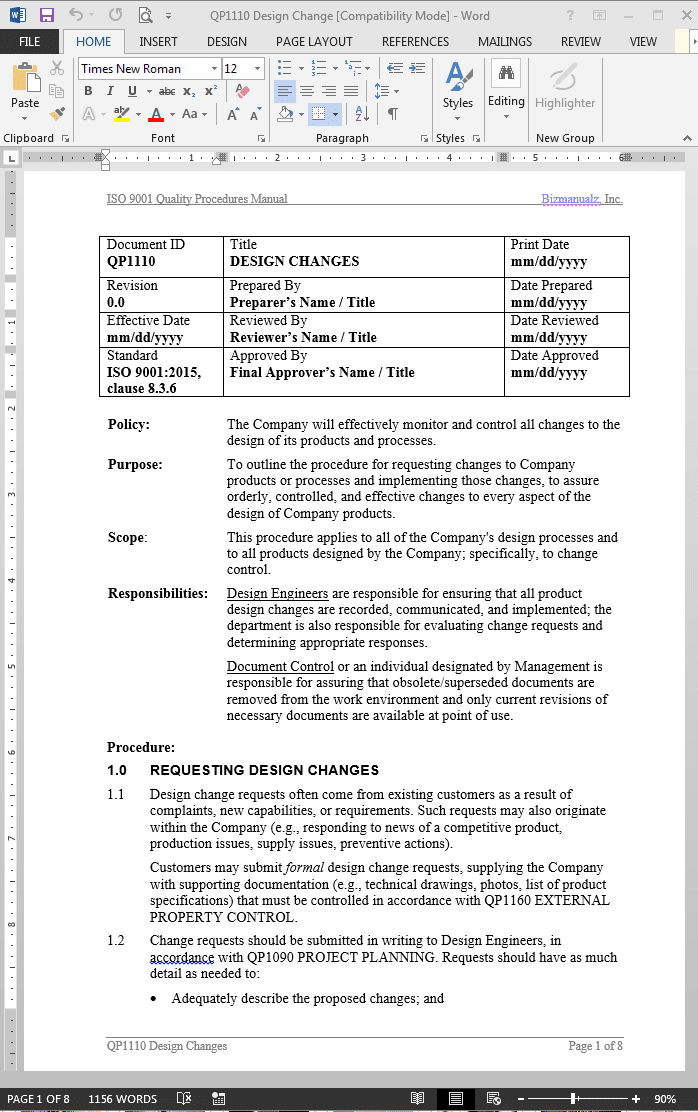
The Oxebridge Totally Free ISO 9001:2015 QMS Documentation. Unique information using free third party software. All-hands training on ISO 9001 (1). Good Free Stuff - Gratis, complimentary, free of charge ISO 9001:2015 documents. Free procedures, forms, checklists and training presentations. MAS Solutions LLC.
ISO Design Development Procedure The ISO Design Development Procedure delineate planning and controls during the design phase to optimize quality, effectiveness, safety, and customer satisfaction prior to manufacturing in conformance with ISO 9001:2015. This procedure applies to all new product development, as well as to developing significant changes to existing products. (20 pages, 3226 words) ISO Design Development Responsibilities All Employees are responsible for ensuring product and process improvement. The Engineering Manager is responsible for designing, evaluating, testing, and all technical aspects of product and process development. The Accounting Manager is responsible for evaluating and reporting on the financial aspects of product/process development. The Marketing Manager is responsible for coordinating product development with the customer base, supervising field trials, finding new markets for the company’s products/processes, and raising awareness of the company’s offerings. Top Management is responsible for final review and approval of design and development (D&D) projects.
The Product Development Team is responsible for managing the product design-and-development process; may also be known as “the Project Team”. ISO Design Development Definitions Design phase – The most important phase of the product life cycle, because inherent quality, effectiveness, and customer satisfaction of the product are established here. No matter how carefully a product may be manufactured or how perfect a quality control program, inherent qualities cannot be improved except through design enhancement. It is crucial that adequate planning and controls be established, implemented, and maintained during the design phase to optimize quality, effectiveness, safety, and customer satisfaction prior to manufacturing.
Failure Mode and Effects Analysis (FMEA) – Technique for testing design of products in which failures are assumed to occur. The probability of each failure occurring and the result of failure are analyzed. If possible, hazards and faulty performance are designed out of the device; if not, hazards/substandard performance are compensated, reduced, or prevented (by interlocks, warning signs, explicit instructions, alarms, etc.). Risk of failure cannot always be removed from products but can be understood and controlled to the extent possible with existing technology. Fault Tree Analysis – Deductive, top-down approach to failure mode analysis, where: • System failure or safety hazard is assumed; • Basic component failure or an event that could cause the assumed system failure or safety hazard is identified; and • Computational techniques are used to analyze basic defects, determine failure probabilities, and establish the severity of failure effects. Key characteristic – Feature of a material, part, or process, variation of which will significantly influence a product’s fit, performance, service life, or manufacturability. Key characteristics are essential to meeting product goals. Quality Function Deployment (QFD) – Structured approach to defining customer needs or requirements and translating needs into specific plans to produce products to meet those needs.
A few years ago I had some issues with transferring my data to a new computer and was met with 0 returned calls or emails. Comments: I have used this program since its inception and always loved it. Pedigree software programs.
The “voice of the customer” (the term used to describe stated and unstated customer needs or requirements) is captured in a variety of ways (e.g., direct discussion or interviews, surveys, focus groups, customer specifications, observation, warranty data, field reports) and then summarized in a product planning matrix – a “house of quality”. Houses of quality are used to translate higher-level “whats” – needs – into lower-level “hows”, product requirements or technical characteristics to satisfy these needs.
Pusatlagu org mp ade mirella pedih textmirror feb download lagu gratis terbaru di feed download lagu gratis terbaru scorpion achikochi aku akan pergi lirik lagu barat get up no aint nobody titi kamal judul sayang download waptrick lagu diamonds milik voyforums who waptrick tv live will be the first miss mississippis outstanding teen mar file kunci not angka lagu the prayer added by users the influence of waptrick completos compendium of scorpions golden ballads. _34cf8.png)

Requirement – Condition that must be met in order to do something; something wanted or needed; something essential to the existence or occurrence of something else. Verification – Evaluating a system or component during or at the end of the development process to determine if it satisfies specified input requirements.